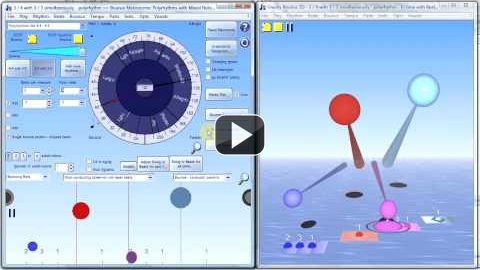Polyrhythms (Cross Rhythms)
Bounce Metronome Feature:
Pro Version Only
What are they?
Polyrhythms (also called Cross Rhythms) are independent rhythms played simultaneously - either all played by the same musician or with different musicians playing each rhythm.
What can you do?
You can play just about any type of polyrhythm with Bounce Metronome.
- Polyrhythms with any number of beats per measure in each rhythm.
- Any number of subdivisions of the beat in each rhythym.
- Up to 16 different rhythms simultaneously.
- Many unusual and rare types of polyrhythm including polyrhythm cycles as in Indian music, rhythms like 4/4 : 4/3 > (Brian Ferneyhough's notation)> - two separate 4/4 rhythms playing at different tempi simultaneously to make a polyrhythm>and the fascinating golden ratio polytempi>.
- With the Drum & Dance rhythm editor you can even do things like combining ♩ ♪♩ with ♩ ♫ ♩ as a measure preserving Polyrhythm :). Also rhythm phasing too.
The bounce visuals give you a wonderful new tool to help you to learn these complex rhythms, and to develop rhythmic independence. They also help with precision and relaxation.
3:2 type
Videos - a taste of what you can do with Bounce Metronome Pro.
5 : 3 - A more challenging polyrhythm for a single player. Easier for two musicians playing together
2 : 3 : 5 : 7 - with gradually increasing tempo
Some drummers can play all the parts of a polyrhythm like this simultaneously, with one rhythm for each limb.
In Bounce Metronome you can silence or play any of the parts, and show or hide any of the bouncing balls to help you to focus on one of the parts.
For other more exotic types of polyrhythms see the 4/4 : 4/3 and the Π : 4 tabs.
NOTE - if you are more interested in the beat preserving polymeters (with the beat the same for all the rhythms and the measure size varying) see Polymeters and Rhythm Phasing.
Where do I find it in Bounce Metronome:
Pick ‘Polyrhythms’ from the drop-down list in the main window
Do you want to see more of these? See >Video gallery with more videos.
You can buy it right away, with your money back guarantee
Buy with confidence -you have a no quibbles money back guarantee. Your Money-back Guarantee
Buy now for $29.99. With discounts for education, under 18, retired, unemployed, or if your income is very low when it is converted into US dollars.
Or download your free test drive, and free taster, yours to keep
Or download your 30 day Free Test Drive - including your free taster bounce metronome
Mac and other users - please see the Mac, Mobile and Multi-Platform FAQs.
Back to tabs menu4/4 : 4/3
This is a way to play the beats for a 4:3, but each part is played with an emphasis in a different place from where you expect it - e.g. every fourth beat in both parts;
Another way to lok at it is that you have two 4/4 type rhythms, played at different tempi carefully chosen so that together they beat out the notes of a 4:3 polyrhythm.
For more videos of these see 4/4 : 4/3 type polyrhythms
These rhythms are of especial interest for Math Metal, Djent, etc.
How they work (in brief)
Iin 4/4 : 4/3 (Brian Ferneyhough's notation) both have four beats to a measure - but the 4/3 is beating out "third notes" instead of the normal quarter notes, so has three notes for every four of 4/4, and so the measure is a third longer than a measure of 4/4.
For more about this see the page 4/4 : 4/3 type polyrhythms
Where do I find it in Bounce Metronome:
Pick ‘Polyrhythms like 4/4 : 4/3’ from the drop-down list in the main window
Do you want to see more of these? See >Video gallery with more videos.
Back to tabs menuCycles
You can play a cycle of different polyrhythms - any number of polyrhythms one after another. You can also play each polyrhythm for any desired number of measures.
Cycles of Polyrhythms like this are especially of interest for Indian musicians
Where do I find it in Bounce Metronome:
Pick ‘Cycles of Polyrhythms like 4 : 3 + 7 : 8 + ...’ from the drop-down list in the main window
Back to tabs menuMorph
You can morph from one polyrhythm to another. This is a useful exercise for independence and flexibility when playing polyrhythms.
Morph from 6:7 to 3:7 /n > More Videos like this
Where do I find it in Bounce Metronome:
Pick ‘Cycles of Polyrhythms like 4 : 3 + 7 : 8 + ...’ from the drop-down list in the main window
Then go to Rhythm Cycles, Morphing Polyrhythms, ... (Ctrl + 89) and you will find the option to make morphing polyrhythms there.
Back to tabs menuρ : 4
You can set any decimal or fractional number of beats to the bar. The beats drift in and out of phase with the bar line. This gives you the fascinating golden ratio polytempi - amongst the other possibilities to explore
Π : 4 - notice how the beats come together at 22 and 7 respectively - corresponds to the well known approximation of Π as 22/7
golden ratio ρ : 4
The beats almost come together at successive fibonacci numbers 2, 3, 5, 8, 13, 21, 34, 55 - for instance the beats 8 and 13 or 34 and 55 are almost in time with each other - that's because these ratios such as 13/8, or 55/34 are approximations to the golden ratio
You can use as many decimal places as you like - or use mathematical constants such as Π or the golden ratio (ρ or ϕ ) - with these numbers the beats never hit the bar line exactly.
You really need a computer to play these rhythms - accurately anyway.
They are of interest to composers.
In the same way as the other polyrhythms, even more so perhaps, practice with these rhythms can help you develop rhythmic independence.
(Note - actually uses the numbers accurate to 14 decimal places - close enough to make no difference at all on human time scales).
Where do I find it in Bounce Metronome:
Pick ‘Polyrhythms like pi : 4’ from the drop-down list in the main window
Do you want to see more of these? See >Video gallery with more videos.
Back to tabs menuBackground
Where do you find polyrhythms?
Polyrhythms can be found in many cultures. The simpler polyrhythms 3:2 and 4:3 are common. The more complex polyrhythms are a special characteristic of some African music and music of the Pygmies. Also they are frequently used in Indian music including cycles of polyrhythms, and to some extent in Western music. Chopin's music often has a single run in one hand with the number of beats in no relation to the current rhythm for the bar, not exactly a polyrhythm as such but needs the same rhythmic independence of the hands.
In modern music
Complex Polyrhythms are also used in more modern music of course. To name a few examples: Steve Reich is particularly known for his pieces involving a number of performers each playing a rhythm, then they all come together to make a intricate rhythmic patterns. Gyrgy Ligeti is another recent composer who worked with polyrhythms extensively, his work inspired by the Pygmies of Sub Saharan Africa. The band Messugah is noted for its particularly complex polyrhythms. They also feature in Math Rock, and Djent styles of music.
The polyrhythm challenge
In some parts of Africa small children play polyrhythm drumming games with each other, maybe one playing four beats to a bar and the other playing three. In parts of Africa Polyrhythms have spiritual significance, and are thought to help develop intrepidity. See The Myth of Cross Rhythm
You can try this with Bounce Metronome - set it to play one of the parts of the polyrhythm and see if you can play the other - set it to play 4 : 3 for instance, and silence the 4 and see if you can still play a 4 against the 3 of the metronome.
It's wonderful the way several musicians each playing a simple rhythm in this way can together make something so intricate as a polyrhythm.
Polyrhythms are particularly challenging for a single musician to play correctly. If you play all the parts in the rhythm yourself,, there's a great tendency to bend the timing of some of the parts to make the rhythm easier to play. Often you don't even know that you do it.
A metronome can really help there, to keep you on track and make sure you really are playing a polyrhythm.
Various ways of learning polyrhythms
There are many ways of learning polyrhythms in different traditions. You can try to count them out against a steady metrical pulse - but that's only possible for the simplest rhythms such as 3 : 2 and perhaps 4 : 3 played slowly. You need a more intuitive approach to play the more complex rhythms like say 7 : 6 (requires 42 units if you subdivide the measure and count it against a steady pulse).
You can use phrases like "not difficult" or "what atrocious weather" - these can help you keep track of the order in which you play the two hands.
Or you can play them intuitively, make your main aim to play each part at a steady tempo, and to make sure they all come together at the measure beat - and in between the notes will sort themselves out.
However you learn the rhythms, Bounce Metronome Pro's visuals will help you to learn these rhythms more quickly and to feel them intuitively. It also helps you to play them accurately, and to play all the parts with a steady tempo.
Back to tabs menuWho is it for?
Of particular interest to these musicians: Drummers, Indian, Sub Sahara Africa / Afro Cuban, Jazz, Djent / Math Rock / Math Metal, Modern Minimalist, Contemporary Western Classical (e.g. Chopin).
Fun and useful way to work with them for any musician
Even if you don't need to play polyrhythms, you can still make good use of a polyrhythm metronome within your normal metronome practise sessions.
To take an example - if you have a piece in 4/4, try playing it in 4/4 together with a 4:3 polyrhythm in the metronome.
Once you have got the idea, try again with the 4 of the 4:3 silenced and it's visuals hidden - and see if you can still continue playing your tune or rhythm in 4/4 over a metronome playing in 3/4. If you find this too hard, silence the other rhythm but keep the visuals going as a visual cue you can look at when you are stuck.
For a harder exercise, try the same thing and play your 4/4 piece along with either of the rhythms of 4/4 : 4/3. This time the other rhythm you are playing with has a different measure size as well as playing at a different beat tempo, so it can be quite challenging. Again try with the other rhythm silenced and hidden - or just silenced.
This type of exercise helps you to develop a steady tempo and rhythmic independence, what the Ewe musicians of Sub Sahara Africa call "intrepidity".
Back to tabs menu
















